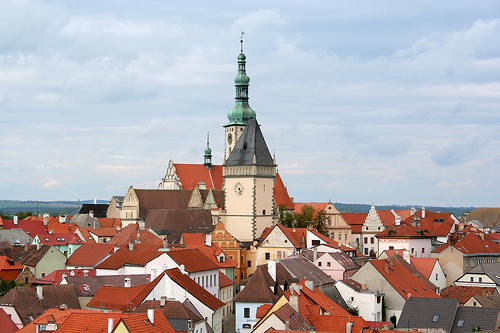

Location: South Bohemian Region Map
Hussite Festival in September
Tábor is a historic town in the South Bohemian Region of the Czech Republic, serving as the second-largest settlement in the area with a population of approximately 34,000 residents. Located about 90 kilometers south of Prague, it lies along a bend in the Lužnice River, nestled amid rolling hills, forests, and agricultural fields that characterize the Bohemian countryside. The town's strategic position on a hilltop has historically provided natural defenses, contributing to its role as a fortified stronghold. Geographically, Tábor benefits from a temperate climate with mild summers and cold winters, and its proximity to natural features like the Jordan Reservoir—the oldest in Central Europe—adds to its scenic appeal.
Founded in 1420 by radical Hussite followers of Jan Hus, Tábor stands
out as one of the few European towns established not by royalty or
nobility but by religious reformers during the Bohemian Reformation. The
Hussites, precursors to the Protestant movement, named the town after
Mount Tabor from the Bible, envisioning it as a utopian community where
all were equal, sharing property in a communal system inspired by early
Christian ideals. Under the leadership of military genius Jan Žižka,
Tábor became a key fortress during the Hussite Wars (1419–1434),
repelling multiple sieges by Catholic forces through innovative tactics
like wagon forts and guerrilla warfare. The town's labyrinthine street
layout was intentionally designed to confuse invaders, a feature that
persists today.
After the wars, Tábor transitioned into a more
conventional town, but its Hussite legacy endured. In the 16th century,
it flourished under Renaissance influences, with notable architecture
emerging. The 19th century brought industrialization and railway
connections, boosting its economy. During World War II, it saw
resistance activities, and post-war, it became part of communist
Czechoslovakia before embracing democracy after the Velvet Revolution in
1989. Today, Tábor preserves its historical essence while adapting to
modern needs.
The heart of Tábor is its well-preserved historic center, a UNESCO
tentative list site, featuring Žižkovo náměstí (Žižka Square), dominated
by the Gothic-Renaissance Town Hall with its clock tower offering
panoramic views. The Church of the Transfiguration of Our Lord on Mount
Tabor, a late-Gothic structure from the 15th century, stands as a
prominent landmark with its tall spire visible from afar. Kotnov Castle,
originally from the 13th century but integrated into Hussite defenses,
now houses the Hussite Museum, which details the movement's history
through artifacts, weapons, and exhibits on daily life.
Underground,
a network of medieval tunnels—used for storage, escape, and
defense—offers guided tours, revealing the town's ingenious engineering.
The Bechyňská Gate and remnants of city walls evoke its fortified past.
Nearby, the Jordan Lake provides recreational opportunities like boating
and fishing, while hiking trails lead to viewpoints overlooking the town
and surrounding landscapes. Other notable sites include the Oskar Nedbal
Theatre and the Botanical Garden, blending cultural and natural
attractions.
Tábor's culture is deeply rooted in its Hussite heritage, celebrated through annual events like the Tábor Meetings (Táborská setkání), featuring historical reenactments, medieval markets, and parades in period costumes. The town hosts music festivals, theater performances, and art exhibitions, reflecting a vibrant local scene. Traditional Czech cuisine, including hearty goulash, dumplings, and local beers, is prominent in its restaurants and breweries. As a regional center, Tábor supports education with schools and a branch of the University of South Bohemia, fostering a community-oriented atmosphere.
Economically, Tábor functions as a transport hub with major rail and road connections, facilitating trade and commuting to Prague. Key sectors include manufacturing (machinery, food processing), services, and tourism, which draws visitors for its history and proximity to other South Bohemian gems like Český Krumlov. The town balances preservation with development, featuring modern amenities like shopping centers alongside historic preservation efforts. With a low unemployment rate and growing eco-tourism focus, Tábor remains a livable, dynamic place that honors its past while looking forward.